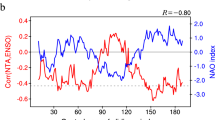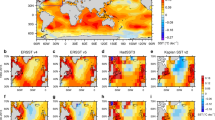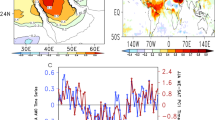Abstract
During the past three decades, tropical sea surface temperature (SST) has shown dipole-like trends, with warming over the tropical Atlantic and Indo-western Pacific but cooling over the eastern Pacific. Competing hypotheses relate this cooling, identified as a driver of the global warming hiatus1,2, to the warming trends in either the Atlantic3,4 or Indian Ocean5. However, the mechanisms, the relative importance and the interactions between these teleconnections remain unclear. Using a state-of-the-art climate model, we show that the Atlantic plays a key role in initiating the tropical-wide teleconnection, and the Atlantic-induced anomalies contribute ∼55–75% of the tropical SST and circulation changes during the satellite era. The Atlantic warming drives easterly wind anomalies over the Indo-western Pacific as Kelvin waves and westerly anomalies over the eastern Pacific as Rossby waves. The wind changes induce an Indo-western Pacific warming through the wind–evaporation–SST effect6,7, and this warming intensifies the La Niña-type response in the tropical Pacific by enhancing the easterly trade winds and through the Bjerknes ocean dynamical processes8. The teleconnection develops into a tropical-wide SST dipole pattern. This mechanism, supported by observations and a hierarchy of climate models, reveals that the tropical ocean basins are more tightly connected than previously thought.
This is a preview of subscription content, access via your institution
Access options
Subscribe to this journal
Receive 12 print issues and online access
$209.00 per year
only $17.42 per issue
Buy this article
- Purchase on Springer Link
- Instant access to full article PDF
Prices may be subject to local taxes which are calculated during checkout



Similar content being viewed by others
References
Kosaka, Y. & Xie, S. P. Recent global-warming hiatus tied to equatorial Pacific surface cooling. Nature 501, 403–407 (2013).
Meehl, G. A. et al. Model-based evidence of deep-ocean heat uptake during surface-temperature hiatus periods. Nature Clim. Change 1, 360–364 (2011).
McGregor, S. et al. Recent Walker circulation strengthening and Pacific cooling amplified by Atlantic warming. Nature Clim. Change 4, 888–892 (2014).
Kucharski, F. I. S., Kang, R. F. & Laura, F. Tropical Pacific response to 20th century Atlantic warming. Geophys. Res. Lett. 38, L03702 (2011).
Luo, J. J., Sasaki, W. & Masumoto, Y. Indian Ocean warming modulates Pacific climate change. Proc. Natl Acad. Sci. USA 109, 18701–18706 (2012).
Xie, S. P. & Philander, S. G. H. A coupled ocean-atmosphere model of relevance to the ITCZ in the eastern Pacific. Tellus A 46, 340–350 (1994).
Xie, S. P. et al. Global warming pattern formation: Sea surface temperature and rainfall. J. Clim. 23, 966–986 (2010).
Bjerknes, J. Atmospheric teleconnections from the equatorial Pacific 1. Mon. Weath. Rev. 97, 163–172 (1969).
Wang, C. An overlooked feature of tropical climate: Inter-Pacific-Atlantic variability. Geophys. Res. Lett. 33, L12702 (2006).
Rodríguez-Fonseca, B. et al. Are Atlantic Niños enhancing Pacific ENSO events in recent decades? Geophys. Res. Lett. 36, L20705 (2009).
England, M. et al. Recent intensification of wind-driven circulation in the Pacific and the ongoing warming hiatus. Nature Clim. Change 4, 222–227 (2014).
Li, X., Holland, D. M., Gerber, E. P. & Yoo, C. Impacts of the north and tropical Atlantic Ocean on the Antarctic Peninsula and sea ice. Nature 505, 538–542 (2014).
Lau, N. C. & Nath, M. J. A modeling study of the relative roles of tropical and extratropical SST anomalies in the variability of the global atmosphere-ocean system. J. Clim. 7, 1184–1207 (1994).
Wallace, J. M. & Gutzler, D. S. Teleconnections in the geopotential height field during the Northern Hemisphere winter. Mon. Weath. Rev. 109, 784–812 (1981).
Alexander, M. A. et al. The atmospheric bridge: The influence of ENSO teleconnections on air-sea interaction over the global oceans. J. Clim. 15, 2205–2231 (2002).
Chang, P., Fang, Y., Saravanan, R., Ji, L. & Seidel, H. The cause of the fragile relationship between the Pacific El Niño and the Atlantic Niño. Nature 443, 324–328 (2006).
Annamalai, H. S. P. X., Xie, S. P., McCreary, J. P. & Murtugudde, R. Impact of Indian Ocean sea surface temperature on developing El Niño. J. Clim. 18, 302–319 (2005).
Kug, J. S., Kirtman, B. P. & Kang, I. S. Interactive feedback between ENSO and the Indian Ocean in an interactive ensemble coupled model. J. Clim. 19, 6371–6381 (2006).
Keenlyside, N. S., Latif, M., Jungclaus, J., Kornblueh, L. & Roeckner, E. Advancing decadal-scale climate prediction in the North Atlantic sector. Nature 453, 84–88 (2008).
Ham, Y. G., Kug, J. S., Park, J. Y. & Jin, F. F. Sea surface temperature in the north tropical Atlantic as a trigger for El Niño/Southern Oscillation events. Nature Geosci. 6, 112–116 (2013).
Kucharski, F., Syed, F. S., Burhan, A., Farah, I. & Gohar, A. Tropical Atlantic influence on Pacific variability and mean state in the twentieth century in observations and CMIP5. Clim. Dynam. 44, 881–896 (2015).
Booth, B. B., Dunstone, N. J., Halloran, P. R., Andrews, T. & Bellouin, N. Aerosols implicated as a prime driver of twentieth-century North Atlantic climate variability. Nature 484, 228–232 (2012).
Schlesinger, M. E. & Ramankutty, N. An oscillation in the global climate system of period 65–70 years. Nature 367, 723–726 (1994).
Zhang, R. & Delworth, T. L. A new method for attributing climate variations over the Atlantic Hurricane Basin’s main development region. Geophys. Res. Lett. 36, L06701 (2009).
Gill, A. Some simple solutions for heat-induced tropical circulation. Q. J. R. Meteorol. Soc. 106, 447–462 (1980).
Vimont, D. J., Battisti, D. S. & Hirst, A. C. Footprinting: A seasonal connection between the tropics and mid-latitudes. Geophys. Res. Lett. 28, 3923–3926 (2001).
Lee, S.-K. et al. Pacific origin of the abrupt increase in Indian Ocean heat content during the warming hiatus. Nature Geosci. 8, 445–449 (2015).
Chikamoto, Y. et al. Skilful multi-year predictions of tropical trans-basin climate variability. Nature Commun. 6, 6869 (2015).
Kucharski, F. et al. Atlantic forcing of Pacific decadal variability. Clim. Dynam. (2015)10.1007/s00382-015-2705-z.
Zhang, R. & Delworth, T. L. Impact of the Atlantic multidecadal oscillation on North Pacific climate variability. Geophys. Res. Lett. 33, L17712 (2006).
Rayner, N. A. et al. Global analyses of sea surface temperature, sea ice, and night marine air temperature since the late nineteenth century. J. Geophys. Res. 108, 4407 (2003).
Kaplan, A. et al. Analyses of global sea surface temperature 1856–1991. J. Geophys. Res. 103, 18567–18589 (1998).
Smith, T. M. & Reynolds, R. W. Extended reconstruction of global sea surface temperatures based on COADS data (1854–1997). J. Clim. 16, 1495–1510 (2003).
Ishii, M., Kimoto, M., Sakamoto, K. & Iwasaki, S. I. Steric sea level changes estimated from historical ocean subsurface temperature and salinity analyses. J. Oceanogr. 62, 155–170 (2006).
Xie, P. et al. GPCP pentad precipitation analyses: An experimental dataset based on gauge observations and satellite estimates. J. Clim. 16, 2197–2214 (2003).
Dee, D. P. et al. The ERA-Interim reanalysis: Configuration and performance of the data assimilation system. Q. J. R. Meteorol. Soc. 137, 553–597 (2011).
Pirani, A. (ed) WCRP Coupled Model Intercomparison Project—Phase 5—CMIP5 (CLIVAR Exchanges special issue No. 56, Vol. 16, May 2011); http://ensembles-eu.metoffice.com/cmug/CLIVAR_Exchange.pdf.
Sen, P. K. Estimates of the regression coefficient based on Kendall’s tau. J. Am. Stat. Assoc. 63, 1379–1389 (1968).
Richard, O. G. Statistical Methods for Environmental Pollution Monitoring (Wiley, 1987).
Bretherton, C. S., Smith, C. & Wallace, J. M. An intercomparison of methods for finding coupled patterns in climate data. J. Clim. 5, 541–560 (1992).
Held, I. M., Max, J. & Suarez, A. Proposal for the intercomparison of the dynamical cores of atmospheric general circulation models. Bull. Am. Meteorol. Soc. 75, 1825–1830 (1994).
James, P. M., Fraedrich, K. & James, I. N. Wave-zonal-flow interaction and ultra-low frequency variability in a simplified global circulation model. Q. J. R. Meteorol. Soc. 120, 1045–1067 (1994).
Yoo, C., Lee, S. & Feldstein, S. B. Arctic response to an MJO-like tropical heating in an idealized GCM. J. Atmos. Sci. 69, 2379–2393 (2012).
Acknowledgements
X.L. was supported by the Scripps Postdoctoral Fellowship; S.-P.X. was supported by the NSF grant AGS-1305719; S.T.G. was supported by the NSF grant OCE-1234473. C.Y. was supported by the Korea Meteorological Administration Research and Development Program under Grant KMIPA 2015–6110. The HadISST sea surface temperature (SST) data were provided by the British Met Office, Hadley Centre. The Kaplan SST and ERSST data sets were provided by the National Oceanic and Atmospheric Administration (NOAA) Earth System Research Laboratory. The Global Precipitation Climatology Project (GPCP) data were provided by the World Climate Research Programme’s (WCRP) Global Energy and Water Exchanges Projects (GEWEX). Ishii subsurface temperature data were provided by the National Center for Atmospheric Research (NCAR) CISL Data Research Archive. The ERA-Interim atmospheric reanalysis was provided by the European Centre for Medium Range Weather Forecasts (ECMWF). We thank the WCRP Working Group on Coupled Modelling, which is responsible for the CMIP multi-model ensemble. The Community Earth System Model, CESM, and its atmospheric component, CAM4, were made available by NCAR, supported by the National Science Foundation (NSF) and the Office of Science (BER) of the US Department of Energy (DOE). The idealized atmospheric model, GFDL dry dynamical core, was developed by NOAA at the Geophysical Fluid Dynamics Laboratory (GFDL). Computing resources were provided by Yellowstone high-performance computing (HPC) in NCAR’s Computational and Information Systems Laboratory, and by the HPC at New York University (NYU).
Author information
Authors and Affiliations
Contributions
X.L., S.-P.X. and S.T.G. designed the experiments; X.L. performed the data analysis and numerical simulations, and prepared all figures; X.L. and C.Y. ran the CESM and GFDL simulations; all authors wrote and reviewed the manuscript.
Corresponding authors
Ethics declarations
Competing interests
The authors declare no competing financial interests.
Supplementary information
Rights and permissions
About this article
Cite this article
Li, X., Xie, SP., Gille, S. et al. Atlantic-induced pan-tropical climate change over the past three decades. Nature Clim Change 6, 275–279 (2016). https://doi.org/10.1038/nclimate2840
Received:
Accepted:
Published:
Issue Date:
DOI: https://doi.org/10.1038/nclimate2840
This article is cited by
-
Large-scale photovoltaic solar farms in the Sahara affect solar power generation potential globally
Communications Earth & Environment (2024)
-
Contributions of external forcing and internal variability to the multidecadal warming rate of East Asia in the present and future climate
npj Climate and Atmospheric Science (2024)
-
Enhanced influence of tropical Atlantic Sea surface temperature anomalies on east Asian summer monsoon since the late 1970s
Climate Dynamics (2024)
-
Reconciling opposite trends in the observed and simulated equatorial Pacific zonal sea surface temperature gradient
Geoscience Letters (2023)
-
Greenhouse warming and internal variability increase extreme and central Pacific El Niño frequency since 1980
Nature Communications (2023)



